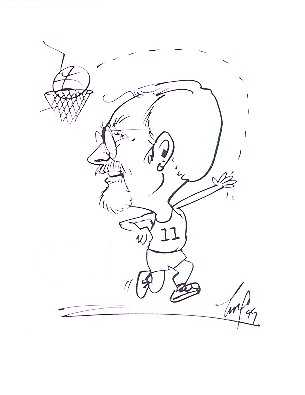ORDA on the Court
All competitive activities have their "X's and O's" -- the strategies that lead either to victory or defeat, and the tactics and techniques one uses to achieve them. Pick-up basketball is no different. Basketball itself is a very simple game: like its cousins (soccer, lacrosse, hockey, water polo, and many others) the object is simply to put the ball in the goal more often than your opponent does. The gimmick is that the goal is 10 feet off the ground, and you aren't allowed to walk with the ball -- you either have to bounce it off the floor or throw it to one of your teammates. One of the things I really love about pick-up hoop is its wide-open potential for creativity and improvisation -- no coaches or elaborate defensive schemes, no set plays other than the classic give-and-go, the pick-and-roll, and a handful of other basic patterns. But this doesn't mean it's all just out-of-control chaos. Like Jazz, effective improvisation occurs within structure. And the more this structure becomes second nature, the easier it becomes to make the improvisation flow naturally.
It begins with with the fundamentals of competition itself: seizing the initiative; quickness and agility; superior strength, skill, power and endurance. Seizing the Initiative means forcing your opponent to react to you, rather than reacting to the actions of your opponent. We sometimes think of this as "the element of surprise," but this is only once aspect of initiative. In basketball we sometimes speak of "controlling tempo" which is less about surprise than it is forcing your opponent to play at your speed. Yet even this is a little deceptive. Seizing the Initiative is most accurately understood as controlling the cycle of Observation, Recognition, Decision and Action (ORDA) -- seeing what is happening on the floor, knowing what it means, making the right choice and acting on it. If you and your teammates can execute this cycle more rapidly than your competition, over and over and over again, over time you will eventually gain the initiative, control the contest, and ultimately defeat them. While they are trying to react to whatever you just did, you are already doing something different, which makes it very difficult to catch up. Not always, of course; superior strength and quickness also have their place in this equation. But as Princeton's Pete Carril puts it, "The Smart Take from the Strong." Experience trumps Athleticism (almost) every time.
Not that Athleticism isn't highly desirable. Quickness and Agility are very important competitive factors, and very closely related to the ORDA cycle. Anticipation makes us faster, while the physical ability to execute quickly might just allow you to outrun an opponent who is a step ahead of you mentally. The legendary John Wooden of UCLA used to say "Move Quickly but never Hurry" (or something along those lines), suggesting that quickness and agility are mental as well as physical. The same is true of physical strength, skill, power and endurance. Basically, stronger and better-conditioned players will be a step faster at the end of the game, even if they start out the game somewhat slower than their competition. The point is to force your opponent to play the game YOUR way, which means playing to your strengths and their weaknesses. The "court sense" that allows you to see the whole floor, recognize the mismatches, find the open player and get them the ball in a place where they can put it in the hole...combine these with old-fashioned values of competitive instinct and "the will to win," and you have the secret to victory at every level, from the playground to the NBA. And if you can figure out how to translate the metaphors, in every other aspect of life as well.


0 Comments:
Post a Comment
<< Home